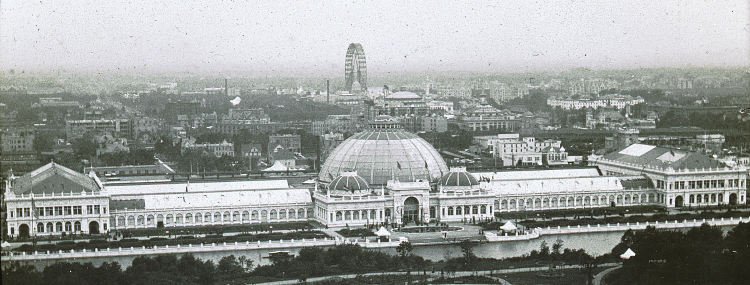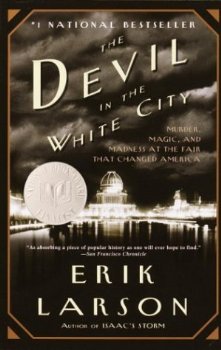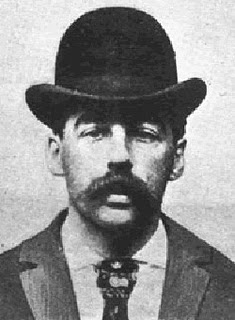
I was lucky enough to find this book years ago, but stupid enough not to read it until 2013. Erik Larson's The Devil in the White City: Murder, Magic, and Madness at the Fair that Changed America is the story on two fronts. One is the story of Daniel Burnham, the chief architect in charge of America's second major exposition in particular after France's unveiling of the Eiffel Tower. The second story is of H. H. Holmes, known as America's first serial killer. These two men, both in Chicago at the same time, never interact, but there stories are intertwined. The story of an architect and a murderer sounds odd, but Larson weaves their stories fantastically and maintains a constant thread throughout the entire book.
 Daniel Burnham--in an amazingly short amount of time--has to design, construct
and prepare nearly 200 buildings as well as oversee the construction of
numerous canals, lagoons, and parks. He had to handle groups wanting to get
too involved, getting together something that would rival Eiffel's magnificent
tower, and battle off people trying to take advantage of the situation like
Wild Bill Cody and Thomas Edison. It's an amazing story and gave me a huge
amount of respect for the fight of getting the 1983 World's Exposition to be
the success that it was. By the way, this expo was the introduction of the
Ferris Wheel. The wheel wasn't even completed by the start of the
fair due to the board's indecision on it and was also placed in an unideal
spot due to both the indecision and the fear that it would not work. It's an
amazing story in and of itself, but only a side discussion this this packed
book.
Daniel Burnham--in an amazingly short amount of time--has to design, construct
and prepare nearly 200 buildings as well as oversee the construction of
numerous canals, lagoons, and parks. He had to handle groups wanting to get
too involved, getting together something that would rival Eiffel's magnificent
tower, and battle off people trying to take advantage of the situation like
Wild Bill Cody and Thomas Edison. It's an amazing story and gave me a huge
amount of respect for the fight of getting the 1983 World's Exposition to be
the success that it was. By the way, this expo was the introduction of the
Ferris Wheel. The wheel wasn't even completed by the start of the
fair due to the board's indecision on it and was also placed in an unideal
spot due to both the indecision and the fear that it would not work. It's an
amazing story in and of itself, but only a side discussion this this packed
book.
 Dr. Henry Howard Holmes is known as America's first serial killer (or in a more
detailed description "first documented serial killer"). Holmes was able build
a "hotel" only a few miles away from the fair and, using his electric
personality, was able to lure many people into his clutches. I say "hotel" due
to the constant changing of contractors and crazy hallways, it was really more
of a kill house. This place had a bank vault for suffocating victims, sealed
bedroom with gas piped into these rooms, a crematorium and surgical room for
turning his victims into medical skeletons. His victim count is thought to be
near 200, but is completely unknown. He was considered wildly charming and
could constantly get his victims to take life insurance policies that he'd pay
and be the benefactor. With all the amazing stories around this, it's crazy
to hear what he was able do what he did under such little suspicion. Different
times.
Dr. Henry Howard Holmes is known as America's first serial killer (or in a more
detailed description "first documented serial killer"). Holmes was able build
a "hotel" only a few miles away from the fair and, using his electric
personality, was able to lure many people into his clutches. I say "hotel" due
to the constant changing of contractors and crazy hallways, it was really more
of a kill house. This place had a bank vault for suffocating victims, sealed
bedroom with gas piped into these rooms, a crematorium and surgical room for
turning his victims into medical skeletons. His victim count is thought to be
near 200, but is completely unknown. He was considered wildly charming and
could constantly get his victims to take life insurance policies that he'd pay
and be the benefactor. With all the amazing stories around this, it's crazy
to hear what he was able do what he did under such little suspicion. Different
times.
I have to say, The Devil in the White City is the best non-fiction book I have ever read. It is an absolute amazing pair of stories, well constructed and exquisitely narrated. Larson does take artistic license in piecing together some of the reports and creating plausible situations. In particular, Larson makes a story reported events instead of simply writing about them. This means situations and conversations are not 100% accurate, but remain within the plausibility of reports, letters, interviews, and the times. It is a great book. One I would recommend to anyone, non-fiction fans or not. It really got me thinking about Chicago as well. It is an absolute shame that the "White City" wasn't constructed for, nor allowed to permanently stand. Photos from the event--best I could find is this from the Brooklyn Museum--are absolutely stunning. I'd love to be able to see the buildings in color to get the full feel of the event. I think of this book to this day and sit in awe of the events of the 1893 World's Columbian Exposition in Chicago, Illinois.
5 Stars
